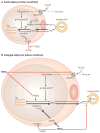Adipocyte dysfunctions linking obesity to insulin resistance and type 2 diabetes
- PMID: 18401346
- PMCID: PMC2886982
- DOI: 10.1038/nrm2391
Adipocyte dysfunctions linking obesity to insulin resistance and type 2 diabetes
Abstract
Acquired resistance to the action of insulin to stimulate glucose transport in skeletal muscle is associated with obesity and promotes the development of type 2 diabetes. In skeletal muscle, insulin resistance can result from high levels of circulating fatty acids that disrupt insulin signalling pathways. However, the severity of insulin resistance varies greatly among obese people. Here we postulate that this variability might reflect differences in levels of lipid-droplet proteins that promote the sequestration of fatty acids within adipocytes in the form of triglycerides, thereby lowering exposure of skeletal muscle to the inhibitory effects of fatty acids.
Figures





References
-
- Flier JS. Obesity wars: molecular progress confronts an expanding epidemic. Cell. 2004;116:337–350. - PubMed
-
- Hogan P, Dall T, Nikolov P. Economic costs of diabetes in the US in 2002. Diabetes Care. 2003;26:917–932. - PubMed
-
- Alberti KG. The costs of non-insulin-dependent diabetes mellitus. Diabet Med. 1997;14:7–9. - PubMed
-
- Clee SM, Attie AD. The genetic landscape of type 2 diabetes in mice. Endocr Rev. 2007;28:48–83. - PubMed
-
- Sims EA, et al. Endocrine and metabolic effects of experimental obesity in man. Recent Prog Horm Res. 1973;29:457–496. - PubMed
Publication types
MeSH terms
Substances
Grants and funding
LinkOut - more resources
Full Text Sources
Other Literature Sources
Medical

